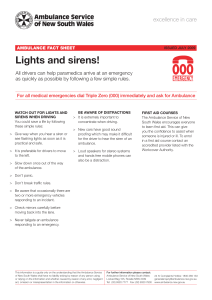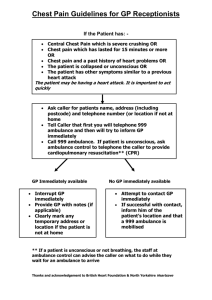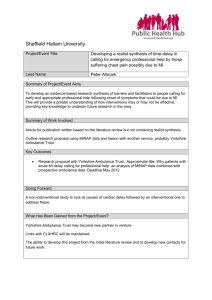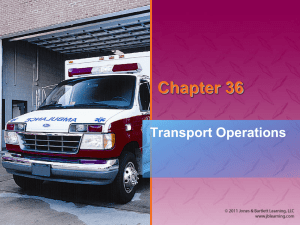Ambulance Operations From Bradys' Emergency Care 10th Edition
advertisement
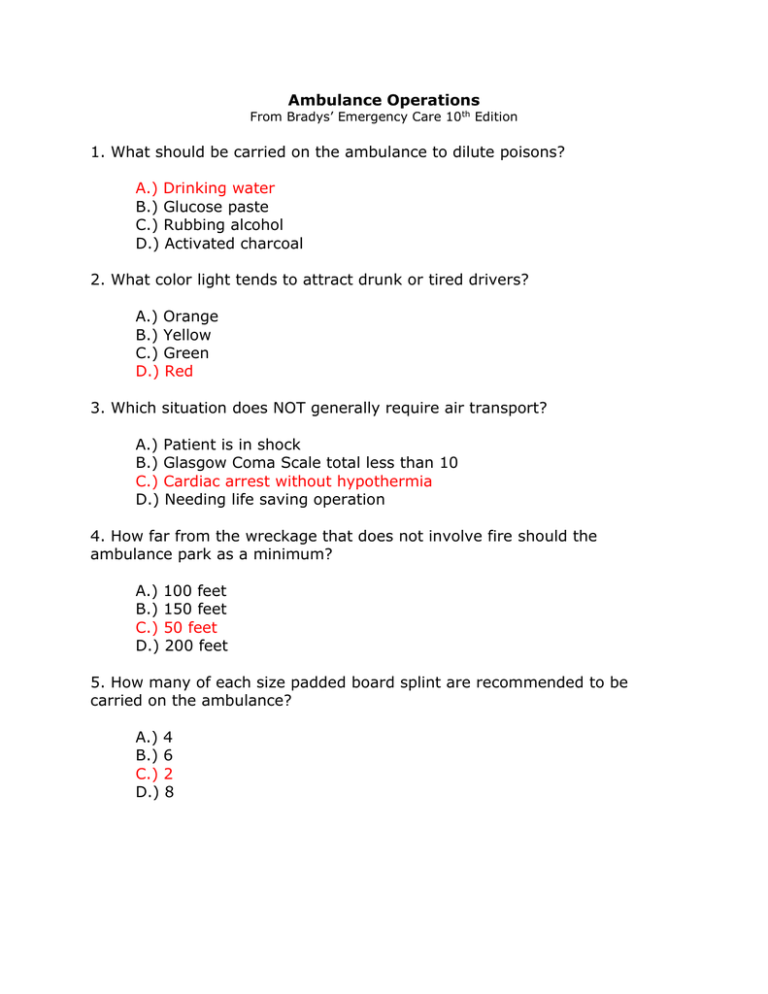
Ambulance Operations From Bradys’ Emergency Care 10th Edition 1. What should be carried on the ambulance to dilute poisons? A.) Drinking water B.) Glucose paste C.) Rubbing alcohol D.) Activated charcoal 2. What color light tends to attract drunk or tired drivers? A.) Orange B.) Yellow C.) Green D.) Red 3. Which situation does NOT generally require air transport? A.) Patient is in shock B.) Glasgow Coma Scale total less than 10 C.) Cardiac arrest without hypothermia D.) Needing life saving operation 4. How far from the wreckage that does not involve fire should the ambulance park as a minimum? A.) 100 feet B.) 150 feet C.) 50 feet D.) 200 feet 5. How many of each size padded board splint are recommended to be carried on the ambulance? A.) 4 B.) 6 C.) 2 D.) 8 6. What ratio of bleach to water should be used to clean blood from the cot mattress? A.) 1:100 B.) 1:1,000 C.) 1:1 D.) 1:10 7. What is the first thing that needs to be done while still at the hospital? A.) Make up the ambulance cot B.) Replace expendable items C.) Quickly clean the patient compartment D.) Prepare respiratory equipment 8. What is the last thing that needs to be done when terminating activities in quarters? A.) Replace patient care equipment B.) Clean the ambulance exterior C.) Change soiled clothing and clean hands D.) Complete any unfinished paperwork 9. When should the prehospital care report be prepared? A.) When the patient's personal effects are moved B.) After the verbal report has been given C.) While getting released from the hospital D.) Upon arrival at the hospital 10. Which is NOT a characteristic of a person who is fit to operate the ambulance? A.) Be tolerant of other drivers B.) Be able to perform under stress C.) Gets an adrenalin rush from the lights and siren D.) Has no impairment that would disable you while driving 11. Where is the best placement of the siren speaker? A.) Vehicle grill B.) Vehicle roof C.) Vehicle door D.) Vehicle hood 12. What is the minimum number of EMT-B's that should be in the patient's compartment to provide care? A.) 1 B.) 4 C.) 2 D.) 3 13. How many soft restraining devices should be carried on the ambulance? A.) 2 B.) 6 C.) 8 D.) 4 14. Which is NOT a requirement before moving a patient to the ambulance who has a spinal injury? A.) Apply cervical collar B.) Administer concentrated oxygen C.) Immobilize on a spine board D.) Manually stabilize the head 15. When should the emergency lights NOT be used on the ambulance? A.) Returning to the station B.) Life-threatening emergency C.) Returning to the hospital D.) Limb-threatening emergency 16. What do adverse driving conditions do to response times? A.) Varies B.) Increases C.) Nothing D.) Decreases 17. Which of the following can be used to kill all forms of microbial life? A.) Lysol B.) Cidex Plus C.) Windex D.) Bleach 18. Which size sterile gauze pads should be carried on the ambulance for wound care? A.) 5 X 5 B.) 10 X 10 C.) 2 X 2 D.) 7 X 7 19. Which part of clothing is NOT something that needs to be loosened to prevent restriction? A.) Belt B.) Collar C.) Sleeve D.) Tie 20. What will make the process of cleaning up the ambulance cot easier? A.) Put the stretcher at the high-level B.) Put the stretcher at the low-level C.) Put the stretcher at the mid-level D.) Put the stretcher on its side 21. What should be done with the stretcher before moving? A.) Tie down the mattress B.) Lock it in place C.) Attach a spine board D.) Retract the wheels 22. What should be the minimum capacity of two portable oxygen delivery systems that are carried on the ambulance? A.) 200 liters B.) 300 liters C.) 350 liters D.) 250 liters 23. How many straps minimum should be on a patient carrying device? A.) 3 B.) 4 C.) 6 D.) 5 24. What should be done when approaching a stopped school bus with its red lights flashing? A.) Blow past the bus B.) Wait for the bus C.) Go around the block D.) Sound the siren 25. How long after the tube is clamped should the fixed suction device reach a pressure of at least 300 mmHg? A.) 6 seconds B.) 4 seconds C.) 5 seconds D.) 2 seconds 26. How many pillow cases should be carried on the ambulance? A.) 5 B.) 3 C.) 2 D.) 4 27. What should be done after the patient compartment has been cleaned and sanitized? A.) Place badly contaminated linens in a biohazard container B.) Take a shower and change into clean clothes C.) Clean and disinfect inhalation therapy equipment D.) Clean any equipment that touched the patient 28. What is the last thing that should be done when inspecting the ambulance with the engine off? A.) Check the fuel level B.) Check dash instruments C.) Check the ambulance body D.) Check windows, doors and mirrors 29. What should be done if the patient develops cardiac arrest? A.) Stop the ambulance B.) Rush to the hospital C.) Turn on lights and siren D.) Slow the ambulance 30. How much is the driving speed increased with an inexperienced ambulance operator when the siren is continually sounded? A.) 15 to 20 mph B.) 20 to 25 mph C.) 5 to 10 mph D.) 10 to 15 mph 31. What must be done for privileges to apply during an emergency situation? A.) Use caution properly B.) Use intuition properly C.) Use turn signals properly D.) Use warning devices properly 32. Which of the following is NOT generally carried in the supplies for childbirth? A.) Five towels B.) Receiving blanket C.) Bandage scissors D.) Sanitary napkins 33. Which is an optional piece of safety and miscellaneous equipment that can be carried on the ambulance? A.) Self-contained breathing apparatus B.) Wheel chocks C.) Multiple-casualty incident management logs D.) Jumper cables 34. How far ahead do most motorists see and hear the lights and siren? A.) 100 to 150 feet B.) 50 to 100 feet C.) 200 to 250 feet D.) 150 to 200 feet 35. What should always be turned on when operating the ambulance? A.) Horn B.) Flashing lights C.) Siren D.) Headlights 36. Which of the following can be used when there is the possibility of a patient developing cardiac arrest during transport? A.) Scooper stretcher B.) Short spine board C.) High-concentration oxygen D.) Pressure bandages 37. What position should a helicopter be approached in when the main rotor is moving? A.) Crouch B.) Sliding C.) Sideways D.) Standing 38. What size range of soft rubber nasopharyngeal airways should be carried on the ambulance? A.) 10 through 24 B.) 14 through 30 C.) 16 through 26 D.) 12 through 32 39. What can be done when there is a disagreeable odor left in the patient compartment? A.) Ride with the windows open B.) Run air conditioning on recirculate C.) Spray an air freshener D.) Apply pure bleach to the area 40. How far should the ambulance park from wreckage involving fire as a minimum? A.) 150 feet B.) 50 feet C.) 200 feet D.) 100 feet 41. What should be checked for when inspecting the interior of the ambulance? A.) Operation B.) Cracks C.) Leaks D.) Cleanliness 42. What should be taken into consideration when deciding to use the lights and siren? A.) Patient's opinion B.) Patient's disposition C.) Patient's location D.) Patient's condition 43. Which area of the helicopter should NEVER be approached? A.) Front window B.) Side door C.) Main rotor D.) Tail rotor 44. Which must be done first when transferring a patient to the ambulance? A.) Load the patient B.) Package the patient C.) Select carrying device D.) Move the patient 45. Which stretcher should be on the ambulance for long-distance carries? A.) Reeves B.) Scoop C.) Stokes D.) Wheeled 46. Which question will provide the chief complaint? A.) What is the exact location of the patient? B.) What's the problem? C.) What is your call-back number? D.) Is the patient conscious? 47. How long should cleaned equipment be hung to dry before being placed back in service? A.) 24 to 36 hours B.) 12 to 24 hours C.) 36 to 48 hours D.) 48 to 60 hours 48. How many accidents happened at an intersection over an 18 year period in New York State? A.) 55% B.) 60% C.) 70% D.) 67% 49. What should be the area that the emergency vehicle should be able to be seen from when all the emergency lights are on? A.) 360 degrees B.) 180 degrees C.) 260 degrees D.) 80 degrees 50. Which is NOT a task of the emergency medical dispatcher who takes a call? A.) Coordinate EMS resources B.) Give pre-arrival medical instructions C.) Advise on needed supplies D.) Interrogate the caller 51. Which would be included in the portable first aid kit for breathing? A.) Bag valve mask B.) Blood pressure cuff C.) Suction D.) Personal protective equipment 52. Which of the following is NOT allowed of an ambulance during an emergency? A.) Go wrong direction on road B.) Drive recklessly C.) Pass in a no pass zone D.) Park the vehicle anywhere 53. Where should a relative be allowed to ride when they do not have an alternative way to get to the hospital? A.) On the stretcher B.) Operator's compartment C.) Patient's compartment D.) Equipment bay 54. What is the maximum level of slope that can be used for a landing zone for the helicopter? A.) 12 degrees B.) 16 degrees C.) 4 degrees D.) 8 degrees 55. What should be used when responding to an emergency and you get close to another vehicle to get their attention? A.) Horn B.) Lights C.) Siren D.) Bump 56. Which check should be done when the ambulance is not running? A.) Check operation of the emergency lights B.) Test the siren for full range of operation C.) Check dash mounted gauges for proper operation D.) Depress the brake pedal for the feel 57. What size zone needs to be clear enough for a helicopter to land? A.) 200 feet X 200 feet B.) 30 feet X 30 feet C.) 100 feet X 100 feet D.) 50 feet X 50 feet 58. What show pride in their work for an EMT-B? A.) Size of the response unit B.) Appearance of the ambulance C.) Newness of the docking station D.) Level of training and education

